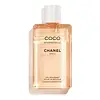What's inside
What's inside
 Key Ingredients
Key Ingredients

 Benefits
Benefits

 Concerns
Concerns

 Ingredients Side-by-side
Ingredients Side-by-side

Water
Skin ConditioningSodium Laureth Sulfate
CleansingParfum
MaskingPPG-26-Buteth-26
Skin ConditioningCocamidopropyl Betaine
CleansingPropylene Glycol
HumectantPEG-40 Hydrogenated Castor Oil
EmulsifyingPolyquaternium-10
Sodium Chloride
MaskingLinalool
PerfumingCitric Acid
BufferingTetrasodium EDTA
Octocrylene
UV AbsorberLimonene
PerfumingHomosalate
Skin ConditioningBenzyl Salicylate
PerfumingButyl Methoxydibenzoylmethane
UV AbsorberGeraniol
PerfumingCitronellol
PerfumingHexyl Cinnamal
PerfumingCoumarin
PerfumingBenzyl Alcohol
PerfumingTocopherol
AntioxidantMethylisothiazolinone
PreservativeHelianthus Annuus Seed Oil
EmollientPhenoxyethanol
PreservativeCI 14700
Cosmetic ColorantCI 19140
Cosmetic ColorantWater, Sodium Laureth Sulfate, Parfum, PPG-26-Buteth-26, Cocamidopropyl Betaine, Propylene Glycol, PEG-40 Hydrogenated Castor Oil, Polyquaternium-10, Sodium Chloride, Linalool, Citric Acid, Tetrasodium EDTA, Octocrylene, Limonene, Homosalate, Benzyl Salicylate, Butyl Methoxydibenzoylmethane, Geraniol, Citronellol, Hexyl Cinnamal, Coumarin, Benzyl Alcohol, Tocopherol, Methylisothiazolinone, Helianthus Annuus Seed Oil, Phenoxyethanol, CI 14700, CI 19140
Water
Skin ConditioningGlycerin
HumectantCaprylic/Capric Triglyceride
MaskingPentylene Glycol
Skin ConditioningPropanediol
SolventCoco-Caprylate/Caprate
EmollientMethylpropanediol
SolventBetaine
HumectantDiglycerin
HumectantLimnanthes Alba Seed Oil
Skin ConditioningButylene Glycol
HumectantOrchid Extract
Skin ConditioningCastor Oil/Ipdi Copolymer
Parfum
MaskingTriheptanoin
Skin ConditioningCarbomer
Emulsion StabilisingAvena Sativa Kernel Extract
AbrasiveC13-15 Alkane
SolventChlorphenesin
AntimicrobialSorbitol
HumectantSodium Hydroxide
BufferingSchisandra Chinensis Fruit Extract
Skin ConditioningAlgin
MaskingMalva Sylvestris Extract
AstringentTrisodium Ethylenediamine Disuccinate
Adenosine
Skin ConditioningSodium Benzoate
MaskingAnigozanthos Flavidus Extract
Skin ConditioningPolyvinyl Alcohol
Pentaerythrityl Tetra-Di-T-Butyl Hydroxyhydrocinnamate
AntioxidantTropaeolum Majus Flower/Leaf/Stem Extract
Skin ConditioningCellulose Gum
Emulsion StabilisingPotassium Sorbate
PreservativeCitric Acid
BufferingCI 77891
Cosmetic ColorantTocopherol
AntioxidantDipalmitoyl Hydroxyproline
Skin ConditioningPolyglyceryl-2 Triisostearate
EmulsifyingTrimethylolpropane Triisostearate
EmollientPropyl Gallate
AntioxidantWater, Glycerin, Caprylic/Capric Triglyceride, Pentylene Glycol, Propanediol, Coco-Caprylate/Caprate, Methylpropanediol, Betaine, Diglycerin, Limnanthes Alba Seed Oil, Butylene Glycol, Orchid Extract, Castor Oil/Ipdi Copolymer, Parfum, Triheptanoin, Carbomer, Avena Sativa Kernel Extract, C13-15 Alkane, Chlorphenesin, Sorbitol, Sodium Hydroxide, Schisandra Chinensis Fruit Extract, Algin, Malva Sylvestris Extract, Trisodium Ethylenediamine Disuccinate, Adenosine, Sodium Benzoate, Anigozanthos Flavidus Extract, Polyvinyl Alcohol, Pentaerythrityl Tetra-Di-T-Butyl Hydroxyhydrocinnamate, Tropaeolum Majus Flower/Leaf/Stem Extract, Cellulose Gum, Potassium Sorbate, Citric Acid, CI 77891, Tocopherol, Dipalmitoyl Hydroxyproline, Polyglyceryl-2 Triisostearate, Trimethylolpropane Triisostearate, Propyl Gallate
Ingredients Explained
These ingredients are found in both products.
Ingredients higher up in an ingredient list are typically present in a larger amount.
Citric Acid is an alpha hydroxy acid (AHA) naturally found in citrus fruits like oranges, lemons, and limes.
Like other AHAs, citric acid can exfoliate skin by breaking down the bonds that hold dead skin cells together. This helps reveal smoother and brighter skin underneath.
However, this exfoliating effect only happens at high concentrations (20%) which can be hard to find in cosmetic products.
Due to this, citric acid is usually included in small amounts as a pH adjuster. This helps keep products slightly more acidic and compatible with skin's natural pH.
In skincare formulas, citric acid can:
While it can provide some skin benefits, research shows lactic acid and glycolic acid are generally more effective and less irritating exfoliants.
Most citric acid used in skincare today is made by fermenting sugars (usually from molasses). This synthetic version is identical to the natural citrus form but easier to stabilize and use in formulations.
Read more about some other popular AHA's here:
Learn more about Citric AcidParfum is a catch-all term for an ingredient or more that is used to give a scent to products.
Also called "fragrance", this ingredient can be a blend of hundreds of chemicals or plant oils. This means every product with "fragrance" or "parfum" in the ingredients list is a different mixture.
For instance, Habanolide is a proprietary trade name for a specific aroma chemical. When used as a fragrance ingredient in cosmetics, most aroma chemicals fall under the broad labeling category of “FRAGRANCE” or “PARFUM” according to EU and US regulations.
The term 'parfum' or 'fragrance' is not regulated in many countries. In many cases, it is up to the brand to define this term.
For instance, many brands choose to label themselves as "fragrance-free" because they are not using synthetic fragrances. However, their products may still contain ingredients such as essential oils that are considered a fragrance by INCI standards.
One example is Calendula flower extract. Calendula is an essential oil that still imparts a scent or 'fragrance'.
Depending on the blend, the ingredients in the mixture can cause allergies and sensitivities on the skin. Some ingredients that are known EU allergens include linalool and citronellol.
Parfum can also be used to mask or cover an unpleasant scent.
The bottom line is: not all fragrances/parfum/ingredients are created equally. If you are worried about fragrances, we recommend taking a closer look at an ingredient. And of course, we always recommend speaking with a professional.
Learn more about ParfumTocopherol (also known as Vitamin E) is a common antioxidant used to help protect the skin from free-radicals and strengthen the skin barrier. It's also fat soluble - this means our skin is great at absorbing it.
Vitamin E also helps keep your natural skin lipids healthy. Your lipid skin barrier naturally consists of lipids, ceramides, and fatty acids. Vitamin E offers extra protection for your skin’s lipid barrier, keeping your skin healthy and nourished.
Another benefit is a bit of UV protection. Vitamin E helps reduce the damage caused by UVB rays. (It should not replace your sunscreen). Combining it with Vitamin C can decrease sunburned cells and hyperpigmentation after UV exposure.
You might have noticed Vitamin E + C often paired together. This is because it is great at stabilizing Vitamin C. Using the two together helps increase the effectiveness of both ingredients.
There are often claims that Vitamin E can reduce/prevent scarring, but these claims haven't been confirmed by scientific research.
Learn more about TocopherolWater. It's the most common cosmetic ingredient of all. You'll usually see it at the top of ingredient lists, meaning that it makes up the largest part of the product.
So why is it so popular? Water most often acts as a solvent - this means that it helps dissolve other ingredients into the formulation.
You'll also recognize water as that liquid we all need to stay alive. If you see this, drink a glass of water. Stay hydrated!
Learn more about Water